Sukhoi Su-30
The Sukhoi Su-30 (Russian: Сухой Су-30; NATO reporting name: Flanker-C) is a twin-engine, two-seat supermaneuverable fighter aircraft developed in the Soviet Union by Russia's Sukhoi Aviation Corporation. It is a multirole fighter for all-weather, air-to-air and air-to-surface deep interdiction missions.
| Su-30 | |
|---|---|
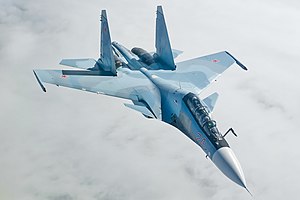 | |
| A Russian Air Force Su-30SM | |
| Role | Multirole fighter[1] |
| Design group | Sukhoi |
| Built by | KnAAPO Irkut Corporation |
| First flight | 31 December 1989 |
| Introduction | 1996 |
| Status | In service |
| Primary users | Russian Air Force Algerian Air Force Venezuelan Air Force Vietnam People's Air Force |
| Produced | 1992–present |
| Number built | 630+[2][3][4][5][6] |
| Unit cost | |
| Developed from | Sukhoi Su-27 |
| Variants | Sukhoi Su-30MKI Sukhoi Su-30MKK Sukhoi Su-30MKM |
The Su-30 started out as an internal development project in the Sukhoi Su-27 family by Sukhoi. The design plan was revamped and the name was made official by the Russian Defense Ministry in 1996. Of the Flanker family, the Su-27, Su-30, Su-33, Su-34 and Su-35 have been ordered into limited or serial production by the Defense Ministry. The Su-30 has two distinct version branches, manufactured by competing organisations: KnAAPO and the Irkut Corporation, both of which come under the Sukhoi group's umbrella.
KnAAPO manufactures the Su-30MKK and the Su-30MK2, which were designed for and sold to China, and later Indonesia, Uganda, Venezuela, and Vietnam. Due to KnAAPO's involvement from the early stages of developing Su-35, these are basically a two-seat version of the mid-1990s Su-35. The Chinese chose an older but lighter radar so the canards could be omitted in return for increased payload. It is a fighter with both air supremacy and attack capabilities, generally similar to the U.S. F-15E Strike Eagle.[8]
Irkut traditionally served the Soviet Air Defense and, in the early years of Flanker development, was given the responsibility of manufacturing the Su-27UB, the two-seat trainer version. When India showed interests in the Su-30, Irkut offered the multirole Su-30MKI, which originated as the Su-27UB modified with avionics appropriate for fighters. Along with its ground-attack capabilities, the series adds features for the air-superiority role, such as canards, thrust-vectoring, and a long-range phased-array radar. Its derivatives include the Su-30MKM, MKA, and SM for Malaysia, Algeria, and Russia, respectively. The Russian Air Force operates several Su-30s and has ordered the Su-30SM version.
Development
While the original Su-27 had good range, it still did not have enough range for the Soviet Air Defense Forces (PVO, as opposed to VVS – the Soviet Air Force). The Air Defense Forces needed to cover the vast expanse of the Soviet Union. Hence, development began in 1986 on the Su-27PU, an improved-capability variant of the Su-27 capable of serving as a long-range interceptor or airborne command post.[9]
The two-seat Su-27UB combat trainer was selected as the basis for the Su-27PU, because it had the performance of a single-seat Su-27 with seating for two crew members. A "proof-of-concept" demonstrator flew 6 June 1987, and this success led to the kick-off of development work on two Su-27PU prototypes. The first Su-27PU flew at Irkutsk on 31 December 1989, and the first of three pre-production models flew on 14 April 1992.[10]
Design
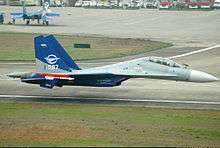
The Su-30 is a multirole fighter. It has a two-seat cockpit with an airbrake behind the canopy.
Flight characteristics
The integrated aerodynamic configuration, combined with the thrust vectoring control ability, results in high manoeuvrability and unique takeoff and landing characteristics. Equipped with a digital fly-by-wire system, the Su-30 is able to perform some very advanced manoeuvres, including the Pugachev's Cobra and the tailslide. These manoeuvers quickly decelerate the aircraft, causing a pursuing fighter to overshoot, as well as breaking a Doppler radar-lock, as the relative speed of the aircraft drops below the threshold where the signal registers to the radar.[11]
Powerplant
The aircraft's powerplant incorporates two Saturn AL-31F afterburning low-bypass turbofan engines, fed through intake ramps. Two AL-31Fs, each rated at 123 kN (28,000 lbf) of full afterburning thrust ensures Mach 2 in level flight, 1,350 km/h speed at low altitude, and a 230 m/s climbing rate.
With a normal fuel reserve of 5,270 kg, the Su-30MK is capable of performing a 4.5-hour combat mission with a range of 3,000 km. An aerial refueling system increases the range to 5,200 km (3,200 mi) or flight duration up to 10 hours at cruise altitudes.[12][13]
Avionics
The aircraft features autopilot ability at all flight stages including low-altitude flight in terrain-following radar mode, and individual and group combat employment against air and ground/sea-surface targets. Automatic control system interconnected with the navigation system ensures route flight, target approach, recovery to airfield and landing approach in automatic mode.
Operational history
Russia
In 1994–1996, an initial batch of five original Su-30 (Su-27PU) fighters, contracted for the Russian Defence Ministry, were delivered to 54th Guards Fighter Aviation Regiment based at Savasleyka air base.[14] After the regiment was disbanded in 2002, the aircraft became part of 4th Centre for Combat Employment and Retraining of Personnel in Lipetsk where they were flown mostly by Russian Falcons aerobatic team.[15] No further orders of the variant were made. However, the Russian Defence Ministry was impressed with the export Su-30MKI's performance envelope and ordered a total of 60 Su-30SM fighters, under two contracts signed in March and December 2012, respectively.[16][17] On 21 September 2012, the Su-30SM performed its maiden flight.[18] The Russian Air Force has received first two serial aircraft on 22 November 2012.[17] By end of 2015, 31st Fighter Aviation Regiment, the last aviation regiment of the Russian Aerospace Forces that operated Soviet-made MiG-29A/UBs (izdeliye 9.12/9.13) was fully rearmed with about twenty new Su-30SM fighters.[19][20] All aircraft of the first two contracts were delivered by 2016.[17]
Another 36 aircraft were ordered in April 2016, six of which intended for the Russian Naval Aviation.[21] This was to increase the total number to 116 (88 in the Air Force and 28 in the Navy).[22]
In October–November 2016, eight new aircraft were handed to Russian Knights aerobatic team, replacing the team's six Su-27 fighters. The aircraft are stationed at Kubinka air base, Moscow Oblast.[23]
During the 2017 MAKS International Aviation and Space Salon, it was announced that the Russian Defence Ministry and Irkut Corporation are working on modernization of Russia's Su-30SM fighters to a new Su-30SM1 standard. The modernization is aimed on improvements in aircraft's avionics and armament.[24]
The Su-30SM attained full operational capability (FOC) in January 2018, by a resolution of the Russian president.[25]
In August 2019, a contract for undisclosed number of modernized Su-30SM1 fighters was signed. First deliveries to the Russian Aerospace Forces are scheduled for late 2020 with serial deliveries to follow in 2021. The aircraft will receive the N035 Irbis radar and AL-41F1S engines of the Su-35S, what is to standardize and reduce operational costs of the two variants. In addition, Su-30SM1's armament will be enhanced of the new KAB-250 aerial bombs and Kh-59MK2 stealth cruise missiles. Over time, it is planned to modernize all Russia's Su-30SMs to the SM1 standard.[26]
2015 Russian military intervention in Syria
In September 2015, Russia has deployed for the first time Su-30SM fighters to the Bassel Al-Assad International Airport in Latakia, Syria. At least four Su-30SM fighters were spotted in a satellite photo.[27] In late December 2015, there were 16 Su-30SMs at Khmeimim Air Base.[28] As part of their combat deployment, they provided target illumination for bombers launching airstrikes against Islamist rebel groups.[29][30]
Su-30SMs were initially tasked with aerial escort of Russian attack jets and strategic bombers but conducted also air to ground duties. On 21 March 2017, rebel forces launched a new offensive in the Hama province; a few days later a video emerged showing a Russian Air Force Su-30SM striking ground targets with unguided air-to-ground rockets in a dive attack against the rebels.
On 3 May 2018, a Russian Air Force Su-30 crashed shortly after take-off from the Khmeimim Air Base, killing both crew members.[31]
According to Yury Borisov, the reliability indicators of the Su-30SM and Su-35S deployed to Syria exceeded the projected levels by several times, citing "The achieved reliability indicators… of the new Su-35 and Su-30SM aircraft in intensive combat operation were three-four times higher than the standard."[32]
India
First talks about acquiring of new fighter for the Indian Air Force began in 1994. A year later, Sukhoi Design Bureau has started working on the new fighter based on the original Su-30 design, which later evolved into Su-30MK (Modernizirovannyi Kommercheskiy - Modernised Commercial) and ultimately into Su-30MKI (Modernizirovannyi Kommercheskiy Indiski - Modernised Commercial Indian).[33] On 30 November 1996, Russian state company Rosvooruzhenie (now Rosoboronexport) and Indian Defence Ministry has signed a contract for development and production of eight Su-30Ks and 32 Su-30MKIs for the Indian Air Force.[33][34] In March–July 1997, all eight Su-30Ks of the order were delivered at Lohegaon Air Force Base in India.[35] On 28 December 2000, as part of the Russian-Indian cooperation, a contract worth more than $US3 billion was signed for license production of 140 Su-30MKI fighters at Hindustan Aeronautics Limited (HAL) production plant in Nashik.[34][36] Between 2002–2004, in accordance with the 1996 contract, 32 Su-30MKIs were built by Irkutsk Aviation Plant for the Indian Air Force.[34] From 2004 onwards, production is carried by HAL.
In 2007, India cleared to buy another 40 Su-30MKIs for a total of $US1.6 billion.[37] In March 2010, it was reported India and Russia are negotiating a contract for additional 42 aircraft.[38] The contract worth $US1.6 billion was signed in December 2011, increasing the total number of ordered aircraft up to 272.[39][40] In March 2020, India has completed the production of all 272 Su-30MKIs ordered under previous contracts.[41] The country is also considering acquisition of 12 more fighters to compensate losses over nearly 20 years of operation.[42]
China
.jpg)
To better counter USAF's expanding capabilities in the region, in 1996, an agreement worth US$1.8 billion was reached with Russia to purchase some 38 multirole combat aircraft based on the original Su-30 design. Taking into account China's requirements for its new fighter, the aircraft became known as Su-30MKK (Modernizirovannyi Kommercheskiy Kitayski - Modernised Commercial Chinese).[43]
In March 1999, first prototype took off from Gromov Flight Research Institute in Russia and a year later it appeared at Zhuhai Air Show in China. People's Liberation Army Air Force (PLAAF) has received first batch of ten Su-30MKK fighters in December 2000, following by second and third batches of ten fighters in August and December 2001, respectively. In July 2001, China has ordered 38 more Su-30MKK fighters.[43]
A modified variant, known as Su-30MK2, was negotiated for the People's Liberation Army Naval Air Force (PLANAF) in 2002, with contract for 24 aircraft signed in 2003. All the aircraft were delivered to PLANAF in 2004.[43]
By 2011, about 73 Su-30MKKs were in service with the PLAAF.[44]
Malaysia
Malaysia has ordered 18 Su-30MKMs in May 2003. The first two Su-30MKMs were formally handed over in Irkutsk on 23 May 2007 and arrived in Malaysia at Gong Kedak Air Base in Terengganu on 21 June 2007.[45] As part of the contract agreement, Russia sent the first Malaysian cosmonaut to the International Space Station in October 2007.[46] In 2014, Malaysia had 18 Su-30MKMs in service.[47]
Venezuela
The Government of Venezuela announced on 14 June 2006 it will purchase 24 Su-30MKV fighters from Russia. The first two Su-30MK2s arrived in early December 2006 while another eight were commissioned during 2007; 14 more aircraft arrived in 2008.[48][49] A second batch of 12 Su-30MKVs was also being considered in 2009.[50] It had 24 Su-30MKVs in service by January 2012.[51] In October 2015, Venezuela announced the purchase of 12 more Su-30MKVs from Russia for US$480 million.[52][53]
Algeria
As part of wider US$8 billion deal signed with Russia in 2006, that also included 34 MiG-29 fighters and number of Yak-130 trainers, Algeria has ordered 28 Su-30MKAs for its Air Force. It was to receive additional 16 Su-30MKAs in exchange for the 39 MiG-29s rejected due to quality disputes and old equipment used.[54][55] By 2015, it had 44 Su-30MKAs in service with 14 more on order.[56][57][58]
In September 2019, it has ordered 16 more aircraft that will augment Algeria's current fleet of total 58 Su-30MKA fighters.[59]
Uganda
Signed a contract for six Su-30MK2s in 2010.[60][61] The last two aircraft from the order were delivered in June 2012.[62]
Indonesia
In 2001, reports emerged Indonesia has showed an interest to acquire about 16 Su-30 fighters,[63] as a replacement for its ageing fleet of 12 F-16A/B and F-5E/F fighters. From 2003 to 2011, and because of the U.S-imposed arms embargo against it, it has ordered a combined 11 Su-30MKK/MK2s (2 Su-30MKK and 9 Su-30MK2) for the Air Force.[64] In September 2013, it had all Su-30MKK/MK2s in inventory.[64] The aircraft were upgraded by Belarus in 2019.[65]
Angola
As part of a US$1 billion deal that also includes other equipment and maintenance services for the country, Angola has ordered 12 out of 18 former Indian Su-30K fighters on 16 October 2013. The Su-30Ks were initially delivered to India in 1997–1998, but were returned to Russia in 2007 in exchange for 18 full-fledged Su-30MKI fighters.[66] Angola received first two aircraft in September 2017,[67][68] four in 2018[69] and the rest in April 2019. Angolan Su-30Ks were also upgraded to the "SM" standard.[70]
Vietnam
Vietnam has received about 20 Su-30MKV2s under two contracts signed in 2009 and 2010, respectively.[71] On 21 August 2013, Russia announced it would deliver another batch of 12 Su-30MKV2s under a $450 million contract, with deliveries in 2014–2015.[72]
On 14 June 2016, a Su-30MK2 of the Vietnamese Air Force went missing during a training flight 30–40 km off the coast of Nghệ An Province. The fate of the pilots is unknown. At the time, there were some 32 Su-32MK2s in service.[73]
Kazakhstan
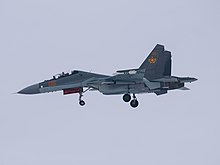
Kazakhstan has ordered in total 24 Su-30SM fighters under three contracts. It received first four Su-30SMs under the first contract worth of RUB5 billion in April 2015.[74][75] A second contract for eight aircraft was signed in December 2015.[76] First two aircraft of the second order were delivered in December 2016[77][78] and another two in December 2017.[79] The third order for 12 more aircraft was approved in August 2017[80][81] and eight aircraft were ordered in May 2018.[82] Last four aircraft of the second contract were delivered in December 2018.[83] It had 12 Su-30SMs in service as of December 2018.[84]
Armenia
In January 2016, then Armenian Defense Minister Seyran Ohanyan mentioned that Russia had discussed the possibility of supplying Su-30 fighters to Armenia during a four-day Russian-Armenian intergovernmental commission on bilateral military-technical cooperation.[85] Armenia has ordered four Su-30SMs in February 2019, with deliveries expected to begin in 2020.[86][87] The country plans to acquire additional Su-30SM aircraft, according to the Armenian Defense Minister David Tonoyan.[88] On 27 December 2019, Armenia has received all four aircraft ahead of schedule. The aircraft landed at the Shirak Airport during a visit of Armenian Defense Minister David Tonoyan and Chief of the General Staff of the Armenian Armed Forces Artak Davtyan.[89][90]
Belarus
In February 2016, Russia and Belarus concluded a preliminary agreement regarding to the export of an undisclosed number of Su-30s to Belarus.[91] On 20 June 2017, during the Le Bourget international air show, Belarus has signed a contract to purchase 12 Su-30SMs under a deal worth US$600 million.[92] Originally to be delivered in 2018,[93][94] first four aircraft landed at Baranovichi Air Base in November 2019.[95]
Potential operators
Iran
In in February 2016, Iran's then Defence Minister Hossein Dehghan during his visit to Moscow announced, that the country intends to buy an undisclosed number of Su-30SM fighters.[96]
Variants
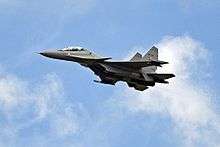
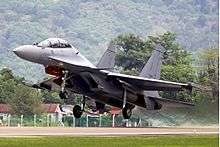
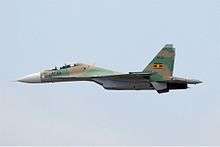
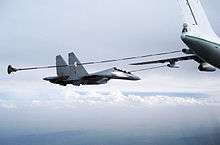
Early variants
- Su-30 (Su-27PU)
- PU for Punkt Upravlenija - "Control Point" or Perechvatcik Uchebnyj - "Interceptor Trainer". Modernized Su-27UB. 5 units operated by the Russian Air Defence Forces.[14]
- Su-30K
- Commercial (export) version of the basic Su-30. The Indian Air Force briefly operated some Su-30Ks in the late 1990s.[33]
- Su-30KI
- Sukhoi proposal for upgrading Russian AF single seat Su-27S. Also proposed export version for Indonesia, 24 were ordered but subsequently cancelled due to the 1997 Asian Financial Crisis.[50]
- Su-30KN
- Upgrade project for operational two-seat fighters, the Su-27UB, Su-30 and Su-30K. This was cancelled in Russia but later revived as Su-30M2. Belarus consider updating ex-Indian Su-30K to the Su-30KN standard.[97]
- Su-30MK
- Commercial version of Su-30M first revealed in 1993. Export versions include navigation and communication equipment from Hindustan Aeronautics Limited.[98]
Su-30MKI and derivatives
- Su-30MKI
- MKI for Modernizirovannyi Kommercheskiy Indiski - "Modernized Commercial Indian". An export version for India, jointly developed with Hindustan Aeronautics Limited (HAL). It is the first Su-30 family member to feature thrust vectoring control (TVC) and canards. Equipped with a multinational avionics complex sourced from Russia, India, France and Israel.[99]
- Su-30MKA
- A version of the Su-30MKI, except with French and Russian avionics for Algeria.[100]
- Su-30MKM
- A derivative of the Russian-Indian Su-30MKI,[101] the MKM is a highly specialised version for Royal Malaysian Air Force. It includes thrust vectoring control (TVC) and canards but with avionics from various countries. It will feature head-up displays (HUD), navigational forward-looking IR system (NAVFLIR) and Damocles Laser Designation pod (LDP) from Thales Group of France, MAW-300 missile approach warning sensor (MAWS), RWS-50 RWR and laser warning sensor (LWS) from SAAB AVITRONICS (South Africa)[102] as well as the Russian NIIP N011M Bars Passive electronically scanned array radar, electronic warfare (EW) system, optical-location system (OLS) and a glass cockpit.[103]
- Su-30SM
- SM for Serijnyi Modernizirovannyi - "Serial Modernized". A specialised version of the thrust-vectoring Su-30MKI for the Russian Air Force, produced by the Irkut Corporation.[104][105] NATO reporting name Flanker-H.
- The Su-30SM is considered a 4+ generation fighter jet.[106][107][108][109][110][111] The aircraft has been upgraded according to Russian military requirements for radar, radio communications systems, friend-or-foe identification system, ejection seats, weapons, and other aircraft systems.[112][113] It is equipped with the N011M Bars radar with a maximum detection range 400 km, search range 200 km using a phased array antenna, frontal horizontal fins and steerable thrusters for supermaneuverability as well as with wide-angle HUD. The aircraft can be used to gain air supremacy same as for targeting adversary on the ground using wide range of weapons including air-to-air, air-to-surface and guided and unguided bombs with total weapons weight up to 8000 kg. It is also equipped with the one barrel, 30 mm GSh-30-1 autocannon. To ensure operations at major distances from airfield, the ability of in-flight refueling (IFR) is included.[105][113][114][115][116][117][118] Besides that, for electronic warfare purposes two SAP-518 jamming pods can be fitted on the wing tips. The SAP-518 is designed to protect the aircraft from various air-to-air and surface-to-air missiles by creating false targets, jamming missile's guidance, enemy aircraft radars or ground and seaborne air defence.[119]
- Su-30SME
- Proposed export version of Su-30SM unveiled at the Singapore Airshow 2016.[120]
- Su-30SM1/SMD
- An upgrade project of Russian Su-30SM fighters, equipped with the N035 Irbis radar and more powerful AL-41F1S engines of the Su-35S, with the goal to reduce operational costs when unifying the two fighters. The modernized fighters will also obtain new types of weapons, namely the KAB-250 aerial bombs and Kh-59MK2 stealth cruise missile. Over time, it is planned to upgrade all Russia's Su-30SMs to the SM1 standard. First deliveries are scheduled for end-2020.[121][122][26]
Su-30MKK and derivatives
- Su-30MKK
- MKK for Modernizirovanniy Kommercheskiy Kitayskiy - "Modernized Commercial for China". An export version for China. NATO reporting name Flanker-G.[123]
- Su-30MK2
- Modernized Su-30MKK for China, Indonesia and Uganda with advanced avionics and weapons.
- Su-30MK2V
- Su-30MK2 variant for Vietnam with minor modifications.[124]
- Su-30MKV
- Export version of Su-30MK2 for Venezuela.
- Su-30M2
- A Su-30MK2 version developed by KnAAPO. The Russian Air Force placed an initial order for the variant in 2009. Factory tests were completed in September 2010.[125][126][127] Twenty aircraft have been ordered; 4 in 2009 and 16 in 2012.[128] At least 12 have been produced as of August 2014, all four from the first contract in 2009, and eight from the second contract of 2012.[128] They are mostly to be used as combat training aircraft for Su-30SM and Su-35S fighters.
- Su-30MK3
- A proposed version with Phazotron Zhuk-MSF radar.
Operators

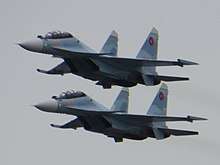
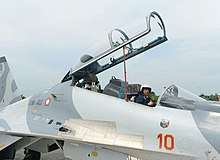
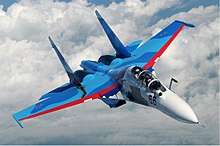
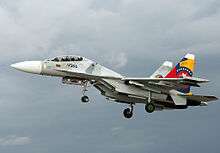

- Algerian Air Force – 58 Su-30MKAs in inventory,[129] 16 more ordered.[59]
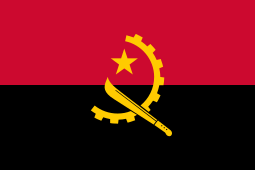
- Angolan Air Force – 12 Su-30Ks in inventory.[70]

- Armenian Air Force – 4 Su-30SMs in inventory, 8 on order.[130]

- People's Liberation Army Air Force – 73 Su-30MKKs in inventory.[44]
- People's Liberation Army Naval Air Force – 24 Su-30MK2s in inventory.[43]

- Belarusian Air Force – 4 Su-30SMs in inventory, 12 ordered.[95]

- Indian Air Force – 272 Su-30MKIs in inventory,[41] 12 ordered.

- Indonesian Air Force – 2 Su-30MKs and 9 Su-30MK2s in inventory.[64]

- Kazakh Air Force – 12 Su-30SMs in inventory, 24 ordered.[84]

- Royal Malaysian Air Force – 18 Su-30MKMs in inventory.[129]

- Myanmar Air Force – 6 Su-30SMEs on order.[131][132][133]

- Russian Air Force – 20 Su-30M2s[134] and 92 Su-30SMs in inventory.[135]
- Russian Naval Aviation – 22 Su-30SMs in inventory, 28 ordered,[135] 50 planned.[136]
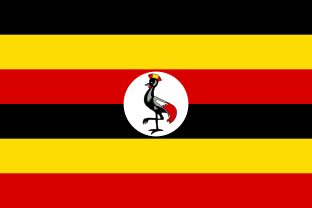
- Ugandan Air Force – 6 Su-30MK2s in inventory.[62]

- Venezuelan Air Force – 22 Su-30MKVs in inventory.[129]

- Vietnam People's Air Force – 32 Su-30MK2Vs in inventory.[73]
Specifications (Su-27PU/Su-30)
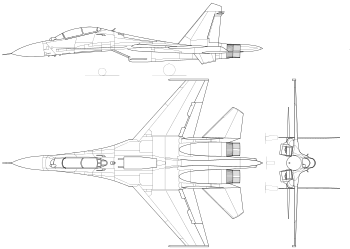
Data from KnAAPO,[12] Sukhoi,[13] Gordon and Davison,[137] deagel.com,[138] airforce-technology.com[139]
General characteristics
- Crew: 2
- Length: 21.935 m (72 ft 0 in)
- Wingspan: 14.7 m (48 ft 3 in)
- Height: 6.36 m (20 ft 10 in)
- Wing area: 62 m2 (670 sq ft)
- Empty weight: 17,700 kg (39,022 lb)
- Gross weight: 24,900 kg (54,895 lb)
- Max takeoff weight: 34,500 kg (76,059 lb)
- Fuel capacity: 9,400 kg (20,723 lb) internal[140]
- Powerplant: 2 × Saturn AL-31FL Afterburning turbofan engines, 74.5 kN (16,700 lbf) thrust each dry, 122.58 kN (27,560 lbf) with afterburner
Performance
- Maximum speed: 2,120 km/h (1,320 mph, 1,140 kn) at high altitude
- Maximum speed: Mach 2
- Range: 3,000 km (1,900 mi, 1,600 nmi) at high altitude
- Service ceiling: 17,300 m (56,800 ft)
- g limits: +9
- Rate of climb: 230 m/s (45,000 ft/min)
- Wing loading: 401 kg/m2 (82 lb/sq ft) with 56% fuel
- 468.3 kg/m2 (95.9 lb/sq ft) with full internal fuel
- Thrust/weight: 1 with 56% fuel
- 0.86 with full internal fuel
Armament
- Guns: 1 × 30 mm Gryazev-Shipunov GSh-30-1 autocannon with 150 rounds
- Hardpoints: 12 hardpoints with a capacity of up to 8,000 kg (18,000 lb),with provisions to carry combinations of:
- Rockets:
- Missiles: ***Air-to-air missiles:
- Bombs:
- KAB-500KR general-purpose bomb
- KAB-500OD bomb
- KAB-1500KR GP bomb
- KAB-1500L laser-guided bomb
- FAB-500T GP bomb
- BETAB-500SHP bomb
- ODAB-500PM bomb
- OFAB-250-270 bomb
- OFAB-100-120 bomb
- P-50T bomb
- RBK-500 cluster bombs
- SPBE-D bomb
- Rockets:
Avionics
Accidents
- On 12 June 1999, a Russian Su-30MK crashed at the Paris Air Show, Le Bourget, France. Both pilots ejected safely and no one was hurt on the ground.[142]
- On 17 September 2015, a Venezuelan Air Force Su-30MK2 crashed in Southern Venezuela, near the town of Elorza while intercepting a small drug-smuggling aircraft.[143] Both pilots died.
- On 3 May 2018, a Russian Su-30SM crashed off the coast of Syria's Jabla. The accident occurred after takeoff.[144] Both pilots died.
See also
Related development
Aircraft of comparable role, configuration and era
- Boeing F/A-18E/F Super Hornet
- McDonnell Douglas F-15E Strike Eagle
- Dassault Rafale
- Eurofighter Typhoon
- Mikoyan MiG-35
Related lists
References
- "Su-30MK page". Sukhoi. Archived from the original on 13 July 2011. Retrieved 3 July 2011.
- "Zbog čega Srbija neće Suhoje?". TangoSix.rs. 25 July 2013. Archived from the original on 13 February 2014. Retrieved 14 February 2014.
- "Delivery of Su-30 MKI Fighters for IAF to get Delayed Due to HAL's Limited Assembly Line". Archived from the original on 22 February 2014.
- "Russian Air Force to Get 21 Su-30 Fighter Jets in 2014". RIA Novosti. 13 February 2014. Archived from the original on 13 February 2014. Retrieved 13 February 2014.
- The Military Balance 2017
- "Поставки боевых самолетов в Вооруженные Силы России в 2017 году". Archived from the original on 24 March 2018. Retrieved 24 March 2018.
- Sputnik (21 August 2013). "Russia to Deliver 12 Su-30 Fighter Jets to Vietnam – Source". rian.ru. Archived from the original on 25 August 2013. Retrieved 1 April 2015.
- "Russia-Libya in billion-dollar arms deal". Moscow Top News. Archived from the original on 7 April 2014. Retrieved 6 April 2014.
- Słupsk, Mariusz Wojciechowski. "Project T-10PU Heavy interceptor fighter Su-27PU (Su-30)". Archived from the original on 22 February 2014. Retrieved 17 February 2014.
- Greg Goebel/chapter 2 of 2/ public domain. "Second-Generation Su-27s & Derivatives". Archived from the original on 22 February 2014. Retrieved 17 February 2014.
- "Discovering Novel Fighter Combat Maneuvers" (PDF). Archived (PDF) from the original on 7 June 2011. Retrieved 17 May 2012.
- "The Su-30MK multipurpose double-seat fighter". knaapo. KNAAPO. 2008. Archived from the original on 24 April 2008. Retrieved 3 August 2019.
- "Su-30MK: Aircraft performance". Sukhoi. Archived from the original on 16 July 2011. Retrieved 3 July 2011.
- "Suchoj Su-27PU/Su-30". Lietadla. Retrieved 15 December 2019.
- "Восстановление истребителей Су-30 (Су-27ПУ)". bmpd.livejournal.com. 28 March 2019. Retrieved 15 December 2019.
- "Sukhoi Su-30SM: An Indian Gift to Russia's Air Force". Sputnik. 23 March 2012. Retrieved 15 December 2019.
- "Russian Military to Get 30 More Su-30SM Fighter Jets". 19 December 2012. Archived from the original on 16 September 2017.
- Reed Business Information Limited. "PICTURES: Irkut launches Su-30SM test campaign". Flight Global. Archived from the original on 18 October 2014. Retrieved 1 April 2015.
- "Россия перевооружит последний авиаполк истребителей МиГ-29". Lenta.ru. 14 October 2015. Retrieved 15 December 2019.
- "What Happened to Russia's Last MiG-29 Regiment?". Sputnik. 16 October 2015. Retrieved 15 December 2019.
- Ведомости (3 April 2016). "Министерство обороны России получит 36 истребителей Су-30СМ". Archived from the original on 12 June 2018. Retrieved 24 March 2018.
- "Вооруженные силы до конца 2018 года получат еще 55 истребителей Су-30СМ". 15 June 2016. Archived from the original on 12 June 2018. Retrieved 24 March 2018.
- ""Русские Витязи" полностью укомплектовали группу новыми самолетами Су-30СМ". bmpd.livejournal.com. 30 November 2016. Retrieved 5 December 2019.
- "MAKS 2017: Russian MoD eyes improved variant of the Su-30SM fighter jet". airrecognition.com. 20 July 2017. Retrieved 7 August 2019.
- "Su-30SM fighter jet officially accepted into VVS service". airrecognition.com. 6 March 2018. Archived from the original on 5 July 2018. Retrieved 8 July 2018.
- "Russian Aerospace Forces to receive upgraded Su-30SM1 fighters". airrecognition.com. 8 August 2019. Retrieved 7 August 2019.
- "Su-30SM fighters in Syria for war". AirForceWorld.com. Archived from the original on 25 September 2015. Retrieved 21 September 2015.
- Cencoti, David. "These photos of everyday life at Hmeymim say a lot about the Russian Air Force operations in Syria". The Aviationist. The Aviationist. Archived from the original on 23 December 2015. Retrieved 23 December 2015.
- "На авиабазе "Хмеймим" в Сирии размещены российские истребители Су-30СМ". РИА Новости. Archived from the original on 7 October 2015. Retrieved 8 October 2015.
- Sputnik. "Perfect Synergy: Su-30SMs Helped Russian Bombers Lock Targets in Syria". sputniknews.com. Archived from the original on 8 August 2016. Retrieved 24 March 2018.
- "Archived copy". Archived from the original on 8 May 2018. Retrieved 8 May 2018.CS1 maint: archived copy as title (link)
- "Russian Aviation in Syria Carried Out Up to 100 Sorties Per Day - Minister". Sputnik (news agency). 17 December 2018. Archived from the original on 20 December 2018. Retrieved 21 December 2018.
- "Су-30МК". sukhoi.org. Retrieved 7 December 2019.
- "Су-30МКИ – основа ВВС Индии". irkut.com. Retrieved 7 December 2019.
- "Су-30МКИ". airwar.ru. Retrieved 7 December 2019.
- "India to build Russian fighters". bbc.co.uk. 28 December 2000. Archived from the original on 25 December 2008. Retrieved 7 December 2019.
- "Aircraft deals with 'friend' Russia costing dear". dnaindia.com. 17 August 2010. Retrieved 7 December 2019.
- "India set to buy 42 more Russian Su-30 fighter jets". en.rian.ru. 2 March 2010. Archived from the original on 3 March 2010. Retrieved 7 December 2019.
- "Индия купила 42 истребителя Су-30МКИ". lenta.ru. 16 December 2011. Retrieved 3 December 2019.
- "ndia to Buy $3 Bln Worth of Russian Warplanes, Helicopters". Sputnik. 24 December 2012. Retrieved 7 December 2019.
- "India completes production of Su-30MKI fighters". airrecognition.com. 2 April 2020. Retrieved 13 April 2020.
- "Индия может закупить у России истребители на $2,5 млрд". vedomosti.ru. 8 October 2019. Retrieved 7 December 2019.
- Wei, Bai (May 2012). "A Flanker by any other name". Air Forces Monthly (290): 72–77.
- "Su-27UBK / Su-30MKK/ Su-30MK2". globalsecurity.org. Retrieved 24 November 2019.
- The Malaysia Deal: Offsets & Updates Archived 19 April 2010 at the Wayback Machine. defenseindustrydaily.com
- Soyuz spacecraft takes first Malaysian into space Archived 21 July 2010 at the Wayback Machine. RT.com
- Reed Business Information Limited. "AirSpace". flightglobal.com. Archived from the original on 25 December 2013. Retrieved 1 April 2015.
- Air Forces Monthly, August 2006 issue.
- Chavez warns U.S. after getting Russian warplanes Archived 7 August 2008 at the Wayback Machine. RIA Novosti,
- Sukhoi Su-27 – Operator List Archived 28 August 2008 at the Wayback Machine. MilAvia.net, 14 March 2009.
- "World Military Aircraft Inventory". 2012 Aerospace. Aviation Week and Space Technology, January 2012.
- "Venezuela allocates $480m to buy Sukhoi aircraft from Russia". airforce-technology.com. Archived from the original on 22 November 2015. Retrieved 2 November 2015.
- "Pese a la crisis económica, Venezuela compra doce cazas rusos". Clarín. 29 October 2015. Archived from the original on 2 November 2015. Retrieved 2 November 2015.
- "Algeria returns 'faulty' MiG-29s". Flight Global. 25 February 2008. Retrieved 25 November 2019.
- "Russia investigates MiG part sales to Algeria". Defence web. 22 September 2009. Retrieved 25 November 2019.
- "Algeria orders additional Su-30 fighters". Defence web. 15 September 2019. Retrieved 25 November 2019.
- "IHS Jane's 360: Algerian Su-30MK order stokes Russian industry rivalry". Jane's. Archived from the original on 17 September 2015. Retrieved 17 September 2015.
- "Russia, Algeria sign contract for 14 Su-30MKA aircraft". TASS. Archived from the original on 15 September 2015. Retrieved 17 September 2015.
- ""Ведомости" сообщили о планах Алжира купить российские истребители на $2 млрд". Interfax. 9 September 2019. Retrieved 25 November 2019.
- "Russia signs $1.2 bln contract for jet fighter delivery to Algeria, Uganda". RIA Novosti. Archived from the original on 8 April 2010. Retrieved 17 May 2012.
- Tabu Butagira, Martin Ssebuyira, "New Russian-built jet fighters arrive" Archived 30 September 2017 at the Wayback Machine. Daily Monitor (13 July 2011).
- "Uganda receives final Su-30s from Russia". Defenceweb. 7 June 2012. Archived from the original on 21 November 2015. Retrieved 2 September 2013.
- "Indonesian government say it's interested in Russia's Sukhoi Su-30". Aviation Week. 6 August 2001. Retrieved 25 November 2019.
- "Indonesia's Air Force Adds More Flankers". Defense industry daily. 10 May 2013. Archived from the original on 22 September 2013.
- "Indonesia receives two more upgraded Su-30s". janes. 14 August 2019. Retrieved 25 November 2019.
- Angola Inks $1Bln Arms Deals With Russia Archived 17 October 2013 at the Wayback Machine – Rian.ru, 16 October 2013
- "Ангола получила два первых истребителя Су-30К". bmpd.livejournal.com (in Russian). 20 September 2017. Archived from the original on 22 September 2017. Retrieved 22 September 2017.
- Binnie, Jeremy (20 September 2017). "Angola receives first Su-30K fighters". IHS Jane's 360. Archived from the original on 22 September 2017. Retrieved 22 September 2017.
- "Истребители Су-30К ВВС Анголы". bmpd.livejournal.com. 26 January 2019. Retrieved 26 January 2019.
- "Белоруссия завершила передачу Анголе 12 доработанных российских истребителей Су-30К". TASS. 16 May 2019. Retrieved 19 May 2019.
- "Russia to Deliver 12 Su-30 Fighter Jets to Vietnam – Source". Sputnik. 21 August 2013. Retrieved 25 November 2019.
- "Russia to Deliver 12 Su-30 Fighter Jets to Vietnam – Source". Sputnik. 21 August 2013. Retrieved 5 December 2019.
- "Vietnamese Air Force's Sukhoi SU-30 MK2 fighter jet goes missing". airforce-technology.com. 14 June 2016. Retrieved 25 November 2019.
- "Казахстан получил истребители Су-30СМ". bmpd.livejournal.com. 18 April 2015. Archived from the original on 4 January 2018. Retrieved 27 December 2018.
- "Kazakhstan to acquire Su-30SM fighters". Jane's Information Group. 4 February 2015. Archived from the original on 21 November 2015. Retrieved 29 December 2017.
- "Казахстан приобретет еще семь истребителей Су-30СМ". bmpd.livejournal.com. 24 December 2015. Archived from the original on 2 January 2018. Retrieved 27 December 2018.
- "Казахстан получил еще два истребителя Су-30СМ". bmpd.livejournal.com. 28 December 2016. Archived from the original on 16 June 2017. Retrieved 27 December 2018.
- "Партия истребителей Су-30СМ прибыла в Казахстан". armstrade.org. 27 December 2016. Archived from the original on 13 September 2017. Retrieved 13 September 2017.
- "Казахстан получил еще два истребителя Су-30СМ". bmpd.livejournal.com. 28 December 2017. Retrieved 27 December 2018.
- "Казахстан закупает в России еще 12 истребителей Су-30СМ". bmpd.livejournal.com. 13 September 2017. Archived from the original on 18 September 2017. Retrieved 13 September 2017.
- "Russia, Kazakhstan sign contract for supply of 12 Su-30SM jets". TASS. Moscow. 12 September 2017. Archived from the original on 13 September 2017. Retrieved 13 September 2017.
- "Russia's aircraft corporation to deliver Su-30SM fighter jets to Kazakhstan". TASS. 24 May 2018. Archived from the original on 25 May 2018. Retrieved 26 May 2018.
- "Казахстан получил еще четыре истребителя Су-30СМ". bmpd.livejournal.com. 27 December 2018. Retrieved 27 December 2018.
- Fediushko, Dmitry (28 December 2018). "Kazakhstan receives four more Su-30SM fighter aircraft". IHS Jane's 360. Moscow. Archived from the original on 28 December 2018. Retrieved 28 December 2018.
- "Armenia may acquire Russia-made Iskander-M missiles, Su-30 fighters". Reuters. Archived from the original on 25 June 2016. Retrieved 23 May 2016.
- Fediushko, Dmitry (5 February 2019). "Armenia to acquire four Su-30SM combat aircraft". Jane's 360. Moscow. Archived from the original on 6 February 2019. Retrieved 6 February 2019.
- Djordjevic, Alexandra; Safronov, Ivan (1 February 2019). "Россия продала Армении истребители как себе". Kommersant. Archived from the original on 1 February 2019. Retrieved 6 February 2019.
- "Armenia may purchase additional Su-30SM fighters from Russia, says defense minister". TASS. 13 February 2019. Archived from the original on 25 February 2019. Retrieved 24 February 2019.
- "First batch of Russian-made Su-30SM fighters arrives in Armenia". airrecognition.com. 27 December 2019. Retrieved 27 December 2019.
- "Армения получила четыре истребителя Су-30СМ". bmpd.livejournal.com. 29 December 2019. Retrieved 31 December 2019.
- Jennings, Gareth (10 February 2016). "Russia and Belarus agree Su-30 deal". Jane's Defence Weekly. Surrey, UK: Jane's Information Group. 53 (14). ISSN 0265-3818.
- "Does Belarus really need Russian Su-30SM fighters?". belarusdigest.com. 6 July 2017. Retrieved 25 November 2019.
- "Подробности: Беларусь купит 12 истребителей Су-30СМ за российский кре". Белорусский партизан. Archived from the original on 24 June 2017. Retrieved 24 March 2018.
- "Delivery of Su-30SM fighter jets to Belarus postponed to 2019". Air Recognition. 15 February 2018. Archived from the original on 15 February 2018. Retrieved 17 February 2018.
- "Белоруссия получила еще два истребителя Су-30СМ". bmpd.livejournal.com. 21 November 2019. Retrieved 25 November 2019.
- "Russia to sign contract this year to sell Su-30SM fighter jets to Iran". Reuters. 13 June 2018. Archived from the original on 17 February 2016. Retrieved 17 February 2016.
- "Belarus may buy outdated Su-30 fighters from Russia" Archived 23 September 2011 at the Wayback Machine.
- "Sukhoi SU-30M technical data". 16 November 2011. Archived from the original on 22 August 2013. Retrieved 17 February 2014.
- "SU30MKI". Aircraftinaction.co.uk. Archived from the original on 18 January 2012. Retrieved 17 May 2012.
- "Sukhoi Su-30-story in colours. Sukhoi Su-30 fighter worldwide camouflage and painting schemes. Prototypes, experimental planes, variants, serial and licensed production, deliveries, units, numbers. Russia, India, China, Malaysia, Venezuela, Belarus, Ukraine, Algeria, Vietnam, Eritrea, Angola, Uganda". mars.slupsk.pl. Archived from the original on 10 January 2015. Retrieved 1 April 2015.
- "The Hindu : India, Russia to make fighter variant for Malaysia". hinduonnet.com. Archived from the original on 6 June 2011. Retrieved 1 April 2015.
- "Archived copy" (PDF). Archived from the original (PDF) on 9 December 2014. Retrieved 21 January 2015.CS1 maint: archived copy as title (link)
- "The first two serially produced Su-30MKM fighters for the Royal Malaysian Air Force has been demonstrated" (Press release). Irkut Corporation. 24 May 2007. Archived from the original on 7 March 2008.
- Karnozov, Vladimir. "Russian air force orders thrust-vectoring Su-30SM fighters" Archived 24 July 2011 at the Wayback Machine. Flight International, 21 July 2011.
- "Malaysia's SU-30MKMs – Will a New Competition Bring More?". Defenseindustrydaily.com. 18 March 2014. Archived from the original on 19 April 2010. Retrieved 4 January 2019.
- "The Aviationist » Satellite image shows four Russian Su-30SM parked in the open air at airfield in Syria". The Aviationist. Archived from the original on 4 October 2015. Retrieved 6 October 2015.
- Sputnik (4 September 2015). "Russia's Black Sea Fleet in Crimea Receives SU-30SM Fighters". Archived from the original on 7 October 2015. Retrieved 6 October 2015.
- "bellingcat – Russian SU-30SM in Syria, not SU-27 – bellingcat". bellingcat. Archived from the original on 3 October 2015. Retrieved 6 October 2015.
- "Here's a stunning video (including cockpit footage) of the awesome Sukhoi Su-30SM". The Aviationist. Archived from the original on 8 October 2015. Retrieved 6 October 2015.
- "Fighter generations comparison chart". The Aviationist. Archived from the original on 17 May 2015. Retrieved 28 May 2015.
- "Air Force Magazine". googleusercontent.com. Archived from the original on 3 March 2016. Retrieved 17 September 2015.CS1 maint: BOT: original-url status unknown (link)
- "Russia's Su-30SM to be showcased at KADEX-2014". Global Aviation Report. Archived from the original on 7 April 2015. Retrieved 1 April 2015.
- "Archived copy" (PDF). Archived from the original (PDF) on 4 September 2014. Retrieved 21 January 2015.CS1 maint: archived copy as title (link)
- "Russia's new air force is a mystery". The Week. Archived from the original on 11 January 2015. Retrieved 1 April 2015.
- "Archived copy" (PDF). Archived from the original (PDF) on 9 September 2014. Retrieved 21 January 2015.CS1 maint: archived copy as title (link)
- "Archived copy" (PDF). Archived from the original (PDF) on 5 September 2014. Retrieved 21 January 2015.CS1 maint: archived copy as title (link)
- "Kursk Air Regiment receives new Su-30SM fighter jets". Airrecognition.com. 4 July 2018. Archived from the original on 5 July 2018. Retrieved 4 January 2019.
- "Kursk Air Regiment receives new Su-30SM fighter jets". airrecognition.com. 4 July 2018. Archived from the original on 5 July 2018. Retrieved 8 July 2018.
- "Russian Su-30SMs to be fitted with SAP-518 jamming pods following Syrian experience". airecognition.com. 29 June 2018. Archived from the original on 8 July 2018. Retrieved 8 July 2018.
- RGareth Jennings. "Singapore Airshow 2016: Russia reveals new Su-30SME 'Flanker' fighter". Janes Defence. Archived from the original on 19 February 2016. Retrieved 19 February 2016.
- "Су-30СМ с изделием 117С станет Су-30СМД". lenta.ru. 15 July 2019. Retrieved 17 July 2019.
- "Су-30СМ и Су-35 унифицируют". lenta.ru. 26 February 2019. Retrieved 17 July 2019.
- "Двухместный многоцелевой истребитель Су-30 (Flanker-C)". vpk.name. Archived from the original on 23 April 2019. Retrieved 11 May 2019.
- Russia, Vietnam ink submarine, arms deal Archived 7 January 2010 at the Wayback Machine, spacewar.com, 2009-12-21, accessed 22 December 2009.
- "First serial Su-30M2 completed test flights" (Press release). Sukhoi. 28 September 2010. Archived from the original on 24 July 2011. Retrieved 3 July 2011.
- "Su-27 Flanker Variants Overview" Archived 28 September 2011 at the Wayback Machine. Milavia, 18 February 2010.
- "Airbase in Krasnodar region will accommodate ten Su-30M2". Lenta.ru. Archived from the original on 13 December 2011. Retrieved 17 May 2012.
- "bmpd". livejournal.com. Archived from the original on 10 August 2014. Retrieved 1 April 2015.
- "World Air Forces 2019". Flightglobal Insight. 2019. Archived from the original on 23 January 2019. Retrieved 3 December 2019.
- "World Air Forces 2019". Flightglobal Insight. 2019. Archived from the original on
|archive-url=requires|archive-date=(help). Retrieved 3 December 2019. - "Moscow to deliver six Su-30 fighter aircraft to Myanmar". TASS. Naypyidaw, Myanmar. 22 January 2018. Archived from the original on 22 January 2018. Retrieved 22 January 2018.
- Osborn, Andrew; Ostroukh, Andrey (22 January 2018). "Russia to sell six SU-30 warplanes to Myanmar: RIA". Reuters. Moscow. Archived from the original on 22 January 2018. Retrieved 22 January 2018.
- "Новые подробности о закупке Мьянмой истребителей Су-30СМЭ". bmpd. 23 January 2018. Retrieved 24 January 2018.
- "ВКС России получили последние два истребителя Су-30М2". bmpd.livejournal.com. 9 April 2016. Retrieved 5 December 2019.
- "ВКС России поставлен последний истребитель Су-30СМ по гособоронзаказу 2018 года". bmpd.livejournal.com. 25 December 2018. Retrieved 5 December 2019.
- "Минобороны и "Иркут" подписали контракт на поставку первых истребителей Су-30СМ для ВМФ". flotprom.ru. 17 January 2014. Retrieved 5 December 2019.
- Gordon and Davison 2006, pp. 92, 95–96.
- "Su-30". www.deagel.com. Archived from the original on 27 March 2018. Retrieved 24 March 2018.
- "Su-30M Flanker-H Air-Superiority Fighter – Airforce Technology". Archived from the original on 3 October 2005. Retrieved 24 March 2018.
- "Su-30M Flanker-H Air-Superiority Fighter – Airforce Technology". airforce-technology.com. Archived from the original on 3 October 2005. Retrieved 1 April 2015.
- https://www.janes.com/images/assets/018/45018/Sky_searchers.pdf
- Gordon, Yefim & Davidson, Peter. 2006. "Sukhoi Su-27 Flanker", p. 46. Warbird Tech Series, vol. 42. ISBN 978-1-58007-091-1.
- "Venezuela's Maduro Confirms 2 Deaths in Fighter Jet Crash". Archived from the original on 27 September 2015. Retrieved 20 September 2015.
- "Russian Su-30SM fighter jet crashes in Syria". Archived from the original on 23 March 2019. Retrieved 23 March 2019.
- Gordon, Yefim and Peter Davison. Sukhoi Su-27 Flanker. Specialty Press, 2006. ISBN 978-1-58007-091-1.
Further reading
- Eden, Paul (ed.). The Encyclopedia of Modern Military Aircraft. London, UK: Amber Books, 2004. ISBN 1-904687-84-9.
- Gordon, Yefim. Sukhoi Su-27 Flanker: Air Superiority Fighter. Airlife Publishing, 1999. ISBN 1-84037-029-7.
- Williams, Mel (ed.). "Sukhoi 'Super Flankers'". Superfighters: The Next Generation of Combat Aircraft. Norwalk, Connecticut: AIRtime Publishing Inc., 2002. ISBN 1-880588-53-6.
External links
| Wikimedia Commons has media related to: |
- Official Sukhoi Su-30MK webpage at Sukhoi and KnAAPO
- Official Sukhoi Su-30MK2 webpage at KnAAPO
- Su-30 page on milavia.net
- Su-30 page on globalsecurity.org
- Sukhoi Flankers – The Shifting Balance of Regional Air Power
- Su-30 page on Fighter Tactics Academy site
- Asia's Advanced Flankers on ausairpower.net
- Sukhoi Su-30 photo pool on Flickr